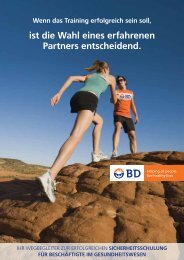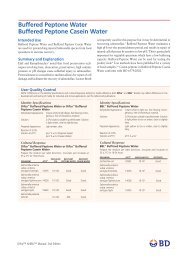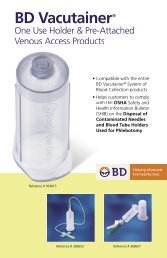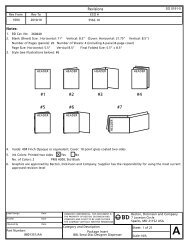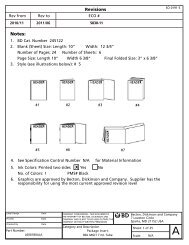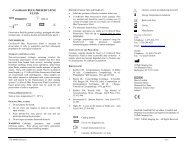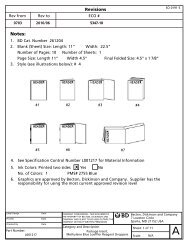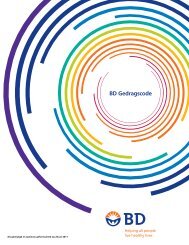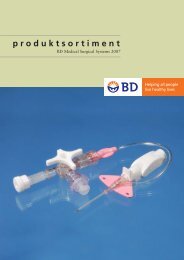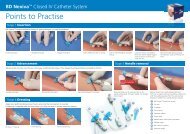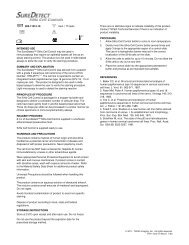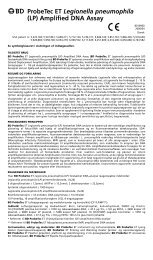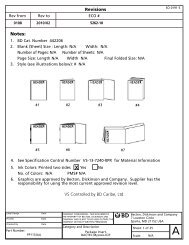BBLâ„¢ Sorbitol MacConkey II Agar with Cefixime and Tellurite - BD
BBLâ„¢ Sorbitol MacConkey II Agar with Cefixime and Tellurite - BD
BBLâ„¢ Sorbitol MacConkey II Agar with Cefixime and Tellurite - BD
You also want an ePaper? Increase the reach of your titles
YUMPU automatically turns print PDFs into web optimized ePapers that Google loves.
B<br />
BBL <strong>Sorbitol</strong> <strong>MacConkey</strong> <strong>II</strong> <strong>Agar</strong> <strong>with</strong> <strong>Cefixime</strong> <strong>and</strong> <strong>Tellurite</strong><br />
8809991 • Rev. 02 • February 2012<br />
QUALITY CONTROL PROCEDURES<br />
I INTRODUCTION<br />
<strong>Sorbitol</strong> <strong>MacConkey</strong> <strong>II</strong> <strong>Agar</strong> <strong>with</strong> <strong>Cefixime</strong> <strong>and</strong> <strong>Tellurite</strong> (SMAC-CT) is a selective <strong>and</strong> differential medium for the detection of<br />
Escherichia coli serotype O157:H7.<br />
<strong>II</strong> PERFORMANCE TEST PROCEDURE<br />
1. Inoculate representative samples <strong>with</strong> the cultures listed below.<br />
a. Streak inoculate 1 µL (0.001 mL) from a 4 – 5 h culture of Trypticase Soy Broth diluted to yield 10 6 – 10 7 CFU/mL.<br />
b. Incubate at 36 ± 1°C for 18 – 24 h under appropriate atmospheric conditions.<br />
c. Include plates of a previously tested lot of Trypticase Soy <strong>Agar</strong> <strong>with</strong> 5% Sheep Blood as controls for inhibited organisms.<br />
2. Examine plates after 18 – 24 h for growth <strong>and</strong> colony color.<br />
3. Expected Results<br />
Organisms ATCC Recovery Colony Color<br />
*Escherichia coli<br />
*Escherichia coli O157:H7<br />
Escherichia coli O157:H7<br />
Escherichia coli O157:H7<br />
*Proteus mirabilis<br />
25922<br />
700728<br />
35150<br />
700531<br />
12453<br />
*Recommended organism strain for User Quality Control.<br />
Inhibition (partial to complete)<br />
Fair to heavy growth<br />
Fair to heavy growth<br />
Fair to heavy growth<br />
Inhibition (partial to complete)<br />
Rose Red<br />
Colorless/gray<br />
Colorless/gray<br />
Colorless/gray<br />
N/A<br />
<strong>II</strong>I ADDITIONAL QUALITY CONTROL<br />
1. Examine plates as described under “Product Deterioration.”<br />
2. Visually examine representative plates to assure that any existing physical defects will not interfere <strong>with</strong> use.<br />
3. Determine the pH potentiometrically at room temperature for adherence to the specification of 7.1 ± 0.2.<br />
4. Note the firmness of plates during the inoculation procedure.<br />
5. Incubate uninoculated representative plates at 35 ± 2°C for 72 h <strong>and</strong> examine for microbial contamination.<br />
PRODUCT INFORMATION<br />
IV INTENDED USE<br />
<strong>Sorbitol</strong> <strong>MacConkey</strong> <strong>II</strong> <strong>Agar</strong> <strong>with</strong> <strong>Cefixime</strong> <strong>and</strong> <strong>Tellurite</strong> (SMAC-CT) is used as a selective <strong>and</strong> differential medium for the<br />
detection of Escherichia coli serotype O157:H7.<br />
V SUMMARY AND EXPLANATION<br />
Escherichia coli serotype O157:H7 is a human pathogen associated <strong>with</strong> hemorrhagic colitis 1 that results from the action of<br />
a shiga-like toxin (SLT). On st<strong>and</strong>ard <strong>MacConkey</strong> agar containing lactose, this strain is indistinguishable from other lactosefermenting<br />
E. coli. However, unlike most E. coli strains, E. coli O157:H7 ferments sorbitol slowly or not at all. When sorbitol is<br />
substituted for lactose, the O157:H7 strain fails to ferment the sorbitol, producing colorless colonies, while other E. coli yield<br />
sorbitol-positive pink to red colonies.<br />
The addition of cefixime <strong>and</strong> tellurite inhibits Proteus mirabilis, non-O157 E. coli strains, <strong>and</strong> other sorbitol nonfermenting<br />
strains. 2,3 This inhibition significantly reduces the number of sorbitol nonfermenters that need to be screened during the<br />
attempted isolation of E. coli O157:H7. Most fecal flora that are not inhibited ferment sorbitol <strong>and</strong> appear pink on this<br />
medium, permitting ready recognition of E. coli O157:H7.<br />
VI PRINCIPLES OF THE PROCEDURE<br />
SMAC-CT is modified <strong>MacConkey</strong> <strong>II</strong> <strong>Agar</strong> using sorbitol instead of lactose <strong>and</strong> <strong>with</strong> cefixime <strong>and</strong> tellurite added. <strong>Cefixime</strong><br />
inhibits Proteus spp. <strong>and</strong> tellurite inhibits non-O157 E. coli <strong>and</strong> other organisms, thus improving the selectivity of SMAC-CT for<br />
E. coli O157:H7. Bile salts <strong>and</strong> crystal violet, which inhibit gram-positive bacteria, especially enterococci <strong>and</strong> staphylococci, are<br />
also included.<br />
Differentiation of enteric microorganisms is achieved by the combination of sorbitol <strong>and</strong> the neutral red indicator. Colorless or<br />
pink to red colonies are produced depending upon the ability of the isolate to ferment the carbohydrate sorbitol.<br />
V<strong>II</strong> REAGENTS<br />
<strong>Sorbitol</strong> <strong>MacConkey</strong> <strong>II</strong> <strong>Agar</strong> <strong>with</strong> <strong>Cefixime</strong> <strong>and</strong> <strong>Tellurite</strong> (SMAC-CT)<br />
Approximate Formula* Per Liter Purified Water<br />
Pancreatic Digest of Gelatin .................................... 17.0 g Neutral Red .......................................................0.03 g<br />
Pancreatic Digest of Casein ........................................ 1.5 g Crystal Violet .....................................................0.001 g<br />
Peptic Digest of Animal Tissue .................................. 1.5 g <strong>Agar</strong> .................................................................13.5 g<br />
D-<strong>Sorbitol</strong> .................................................................. 10.0 g <strong>Cefixime</strong> ............................................................0.05 mg<br />
Bile Salts ...................................................................... 1.5 g<br />
Sodium Chloride ......................................................... 5.0 g<br />
*Adjusted <strong>and</strong>/or supplemented as required to meet performance criteria.<br />
Warnings <strong>and</strong> Precautions: For in vitro Diagnostic Use.<br />
Potassium <strong>Tellurite</strong> ...........................................2.5 mg<br />
If excessive moisture is observed, invert the bottom over an off-set lid <strong>and</strong> allow to air dry in order to prevent formation of a<br />
seal between the top <strong>and</strong> bottom of the plate during incubation.<br />
8809991 1 of 3
Storage Instructions: On receipt, store plates in the dark at 2 – 8°C. Avoid freezing <strong>and</strong> overheating. Do not open until ready to<br />
use. Minimize exposure to light. Prepared plates stored in their original sleeve wrapping at 2 – 8°C until just prior to use may<br />
be inoculated up to the expiration date <strong>and</strong> incubated for recommended incubation time. Allow the medium to warm to room<br />
temperature before inoculation. Do not leave the medium at room temperature for more than 24 h.<br />
Product Deterioration: Do not use plates if they show evidence of microbial contamination, discoloration, drying, cracking or<br />
other signs of deterioration.<br />
V<strong>II</strong>I SPECIMEN COLLECTION AND HANDLING<br />
Refer to appropriate texts for details of specimen collection <strong>and</strong> h<strong>and</strong>ling procedures. 4-7<br />
Pathogenic microorganisms, including hepatitus viruses <strong>and</strong> Human Immunodeficiency Virus, may be present in clinical<br />
specimens. “St<strong>and</strong>ard Precautions” 8-11 <strong>and</strong> institutional guidelines should be followed in h<strong>and</strong>ling all items contaminated<br />
<strong>with</strong> blood <strong>and</strong> other body fluids. Prior to discarding, sterilize specimen containers <strong>and</strong> other contaminated materials by<br />
autoclaving.<br />
IX PROCEDURE<br />
Material Provided: <strong>Sorbitol</strong> <strong>MacConkey</strong> <strong>II</strong> <strong>Agar</strong> <strong>with</strong> <strong>Cefixime</strong> <strong>and</strong> <strong>Tellurite</strong>.<br />
Materials Required But Not Provided: Ancillary culture media, reagents, quality control organisms <strong>and</strong> laboratory equipment as<br />
required.<br />
Test Procedure: Observe aseptic techniques.<br />
The agar surface should be smooth <strong>and</strong> moist, but <strong>with</strong>out excessive moisture.<br />
Inoculate the medium as soon as possible after the specimen arrives at the laboratory. To culture a specimen from a swab,<br />
inoculate the medium by rolling the swab over a third of the agar <strong>and</strong> streak the remainder of the agar <strong>with</strong> a sterilized<br />
inoculating loop to obtain isolated colonies. Material not being cultured directly from swabs may be streaked onto the medium<br />
<strong>with</strong> a sterilized inoculating loop. The streak plate technique is used primarily to obtain isolated colonies from specimens<br />
containing mixed flora.<br />
Incubate plates, protected from light, in an inverted position (agar side up) at 35 ± 2°C for 18 – 24 h in an aerobic atmosphere<br />
<strong>with</strong>out additional CO 2 .<br />
User Quality Control: See “Quality Control Procedures.”<br />
Quality control requirements must be performed in accordance <strong>with</strong> applicable local, state <strong>and</strong>/or federal regulations or<br />
accreditation requirements <strong>and</strong> your laboratory’s st<strong>and</strong>ard Quality Control procedures. It is recommended that the user refer to<br />
pertinent CLSI guidance <strong>and</strong> CLIA regulations for appropriate Quality Control practices.<br />
X RESULTS<br />
After 18 – 24 h of incubation, E. coli O157:H7 should show isolated colonies in streaked areas <strong>and</strong> confluent growth in areas of<br />
heavy inoculation.<br />
Most fecal flora will be partially to completely inhibited. <strong>Sorbitol</strong> fermenters that are not inhibited will produce pink to red<br />
colonies, some surrounded by zones of precipitated bile, while sorbitol nonfermenters produce colorless colonies.<br />
Gram staining, biochemical tests <strong>and</strong> serological procedures should be performed to confirm findings. 12 BBL provides a<br />
serological kit for confirmation of O157 <strong>and</strong> H7 antigens.<br />
XI LIMITATIONS OF THE PROCEDURE<br />
This prepared plated medium is intended for primary isolation.<br />
It has been reported that some Enterobacteriaceae <strong>and</strong> Pseudomonas aeruginosa are inhibited on <strong>MacConkey</strong> <strong>Agar</strong> when<br />
incubated in a CO 2 -enriched atmosphere (G. Mazura-Reetz, T.R. Neblett, <strong>and</strong> J.M. Galperin. Abstr. Annu. Meet. Am. Soc.<br />
Microbiol. 1979, C179, p. 339).<br />
Prolonged incubation of the culture beyond 24 h may result in colonies of E. coli serotype O157:H7 losing their characteristic<br />
colorless to gray <strong>with</strong> dark gray centers appearance. There are additional species of facultatively anaerobic gram-negative rods<br />
that do not ferment sorbitol.<br />
A single medium is rarely adequate for detecting all organisms of potential significance in a specimen. The agents in selective<br />
media may inhibit some strains of the desired species or permit the growth of a species they were designed to inhibit,<br />
especially if the species is present in large numbers in the specimen. Specimens cultured on selective media should also be<br />
cultured on nonselective media to obtain additional information <strong>and</strong> help ensure recovery of potential pathogens.<br />
X<strong>II</strong> PERFORMANCE CHARACTERISTICS<br />
Thirty-two (32) E. coli O157:H7 isolates were tested in-house. Additionally, eleven (11) non-O157:H7 E. coli isolates <strong>and</strong> nineteen<br />
(19) other strains were evaluated in-house.<br />
Pure culture suspensions were prepared in BBL Saline, Normal, <strong>and</strong> adjusted to a concentration of 10 5 CFU/plate. Plates of<br />
<strong>Sorbitol</strong> <strong>MacConkey</strong> <strong>II</strong> <strong>Agar</strong> <strong>with</strong> <strong>Cefixime</strong> <strong>and</strong> <strong>Tellurite</strong> were streaked <strong>with</strong> 10 µL of each suspension, incubated for 18 h, <strong>and</strong><br />
read for growth <strong>and</strong> reactions. One hundred percent (100%) correlation was seen between results on test agar <strong>and</strong> expected<br />
results for all 32 E. coli O157:H7 strains tested. Ten of the eleven non-O157 strains were inhibited. All strains grew well on<br />
Trypticase Soy <strong>Agar</strong> <strong>with</strong> 5% Sheep Blood (TSA <strong>II</strong>).<br />
For the nineteen other strains tested, performance results were as expected; growth results ranged from complete to partial<br />
inhibition <strong>and</strong>, if growth occurred, reactions were correct.<br />
Growth occurred <strong>with</strong> Salmonella group N <strong>and</strong> Escherichia hermannii, which are known to cross react <strong>with</strong> E. coli O157<br />
antisera.<br />
X<strong>II</strong>I AVAILABILITY<br />
Cat. No. Description<br />
222226 BBL <strong>Sorbitol</strong> <strong>MacConkey</strong> <strong>II</strong> <strong>Agar</strong> <strong>with</strong> <strong>Cefixime</strong> <strong>and</strong> <strong>Tellurite</strong>, Pkg. of 10 plates<br />
8809991 2 of 3
XIV REFERENCES<br />
1. March, S.B., <strong>and</strong> S. Ratnam. 1986. <strong>Sorbitol</strong>-<strong>MacConkey</strong> medium for detection of Escherichia coli O157:H7 associated <strong>with</strong><br />
hemorrhagic colitis. J. Clin. Microbiol. 23:869-872.<br />
2. S<strong>and</strong>erson, M.W., J.M. Gay, D.D. Hancock, C.C. Gay, L.K. Fox, <strong>and</strong> T.E. Besser. 1995. Sensitivity of bacteriologic culture for<br />
detection of Escherichia coli O157:H7 in bovine feces. J. Clin. Microbiol. 33:2616-2619.<br />
3. Zadik, P.M., P.A. Chapman, <strong>and</strong> C.A. Siddons. 1993. Use of tellurite for the selection of verocytotoxigenic Escherichia coli<br />
O157. J. Med. Microbiol. 39:155-158.<br />
4. Isenberg, H.D., F.D. Schoenknecht, <strong>and</strong> A. von Graevenitz. 1979. Cumitech 9, Collection <strong>and</strong> processing of bacteriological<br />
specimens. Coordinating ed., S.J. Rubin. American Society for Microbiology, Washington, D.C.<br />
5. Forbes, B.A., D.F. Sahm, <strong>and</strong> A.S. Weissfeld. 1998. Bailey & Scott’s diagnostic microbiology, 10th ed. Mosby, Inc., St. Louis.<br />
6. Miller, J.M., <strong>and</strong> H.T. Holmes. 1995. Specimen collection, transport, <strong>and</strong> storage, p. 19-32. In P.R. Murray, E.J. Baron, M.A.<br />
Pfaller, F.C. Tenover, <strong>and</strong> R.H. Yolken (ed.), Manual of clinical microbiology, 6th ed. American Society for Microbiology,<br />
Washington, D.C.<br />
7. U.S. Food <strong>and</strong> Drug Administration. 1995. Bacteriological analytical manual, 8th ed. AOAC International, Gaithersburg, MD.<br />
8. Clinical <strong>and</strong> Laboratory St<strong>and</strong>ards Institute. 2005. Approved Guideline M29-A3. Protection of laboratory workers from<br />
occupationally acquired infections, 3rd ed. CLSI, Wayne, Pa.<br />
9. Garner, J.S. 1996. Hospital Infection Control Practices Advisory Committee, U.S. Department of Health <strong>and</strong> Human Services,<br />
Centers for Disease Control <strong>and</strong> Prevention. Guideline for isolation precautions in hospitals. Infect. Control Hospital<br />
Epidemiol. 17:53-80.<br />
10. U.S. Department of Health <strong>and</strong> Human Services. 2007. Biosafety in microbiological <strong>and</strong> biomedical laboratories, HHS<br />
Publication (CDC), 5th ed. U.S. Government Printing Office, Washington, D.C.<br />
11. Directive 2000/54/EC of the European Parliament <strong>and</strong> of the Council of 18 September 2000 on the protection of workers<br />
from risks related to exposure to biological agents at work (seventh individual directive <strong>with</strong>in the meaning of Article 16(1)<br />
of Directive 89/391/EEC). Official Journal L262, 17/10/2000, p. 0021-0045.<br />
12 Gray, L.D. 1995. Escherichia, Salmonella, Shigella, <strong>and</strong> Yersinia, p. 450-456. In P.R. Murray, E.J. Baron, M.A. Pfaller, F.C.<br />
Tenover, <strong>and</strong> R.H. Yolken (ed.), Manual of clinical microbiology, 6th ed. American Society for Microbiology, Washington, D.C.<br />
Becton, Dickinson <strong>and</strong> Company<br />
7 Loveton Circle<br />
Sparks, MD 21152 USA<br />
800-638-8663<br />
www.bd.com/ds<br />
ATCC is a trademark of the American Type Culture Collection.<br />
<strong>BD</strong>, <strong>BD</strong> Logo, BBL <strong>and</strong> Trypticase are trademarks of Becton, Dickinson <strong>and</strong> Company. ©2012 <strong>BD</strong>.<br />
8809991 3 of 3



